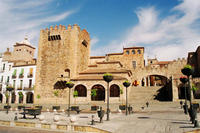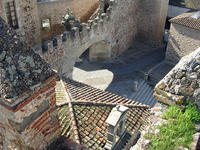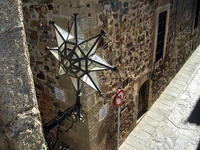You are in: Europe -> Spain -> Old Town of Cáceres, and traditional search or Image Gallery will yield results of this site only
Old Town of Cáceres
| Site number: | 384 |
|
| Type of site: | Cultural | |
| Date: | - | |
| Date of Inscription: | 1986 | |
| Location: | Europe, Spain, Province of Cáceres, Autonomous Community of Extremadura | |
Up to 75 images are shown here. Click on each for more details or on Image Gallery for more images.
| Description: | The site's architecture reveals the city’s history of battles between Moors and Christians. The buildings blend Roman, Islamic, Northern Gothic and Italian Renaissance styles. Out of the site’s 30 or so Muslim period towers, the Torre del Bujaco is the most legendary. --WHMNet paraphrase from the description at WHC Site, where additional information is available. | |
| Cáceres is the capital of Cáceres Province, in Extremadura, Spain (see map). Its population in 2004 was 88,245 (90,750 in 2006). The municipio has a land area of 1,750.33 km² (675.806 sq mi) and is the largest in geographical extent in Spain. Its 2007 census population was 91606 inhabitants. There have been settlements near Cáceres since prehistoric times. Evidence of this can be found in the caves of Maltravieso and El Conejar. The city was founded by the Romans in 25 BC. The old town or Ciudad Monumental still has its ancient walls; this part of town is also well known for its multitude of storks' nests. The walls contain a perfect Medieval town setting with no outward signs of modernity for this reason many films have been shot here. The Universidad de Extremadura, and two astronomical observatory are in Cáceres. Caceres was declared a World Heritage City by UNESCO in 1986 because of the city's blend of Roman, Islamic, Northern Gothic and Italian Renaissance styles, fruit of the many battles fought here throughout history. An amazing 30 towers from the Muslim period still stand in Caceres, of which the Torre del Bujaco is the most famous. After the end of the Roman Empire, the city was occupied by Germanic tribes - the Visigoths - and entered a period of decline and decay until the Arabs conquered Caceres in the eighth century. The city spent the next few centuries mostly under Arab rule, although power alternated several times between Moors and Christians. During this time, the Arabs rebuilt the city, including a wall and various towers, including the Torre de Bujaco, and palaces. Caceres was re-conquered by the Christians in the 13th century. During this period the city had an important Jewish quarter: in the 15th Century when the total population was 2,000, nearly 140 Jewish families lived in Caceres. The Jewish population was expelled in 1492, but many remains which are a result of the Jewish influence during this period can still be seen today in the Barrio San Antonio. Caceres flourished during the Reconquista and the Discovery of America, as influential Spanish families and nobles built homes and small palaces here, and many members of families from Extremadura participated in voyages to America where they made their fortunes. In the 19th century, Caceres became the capital of the province, marking a period of growth which was halted by the Spanish Civil War. --Wikipedia. Text is available under the Creative Commons Attribution-ShareAlike License. | ||
| Source: | http://whc.unesco.org/en/list/384 | |
| Source2: | http://www.google.com/intl/en/landing/unesco/ | |
| Reference: | 1. UNESCO World Heritage Center, Site Page. | |














